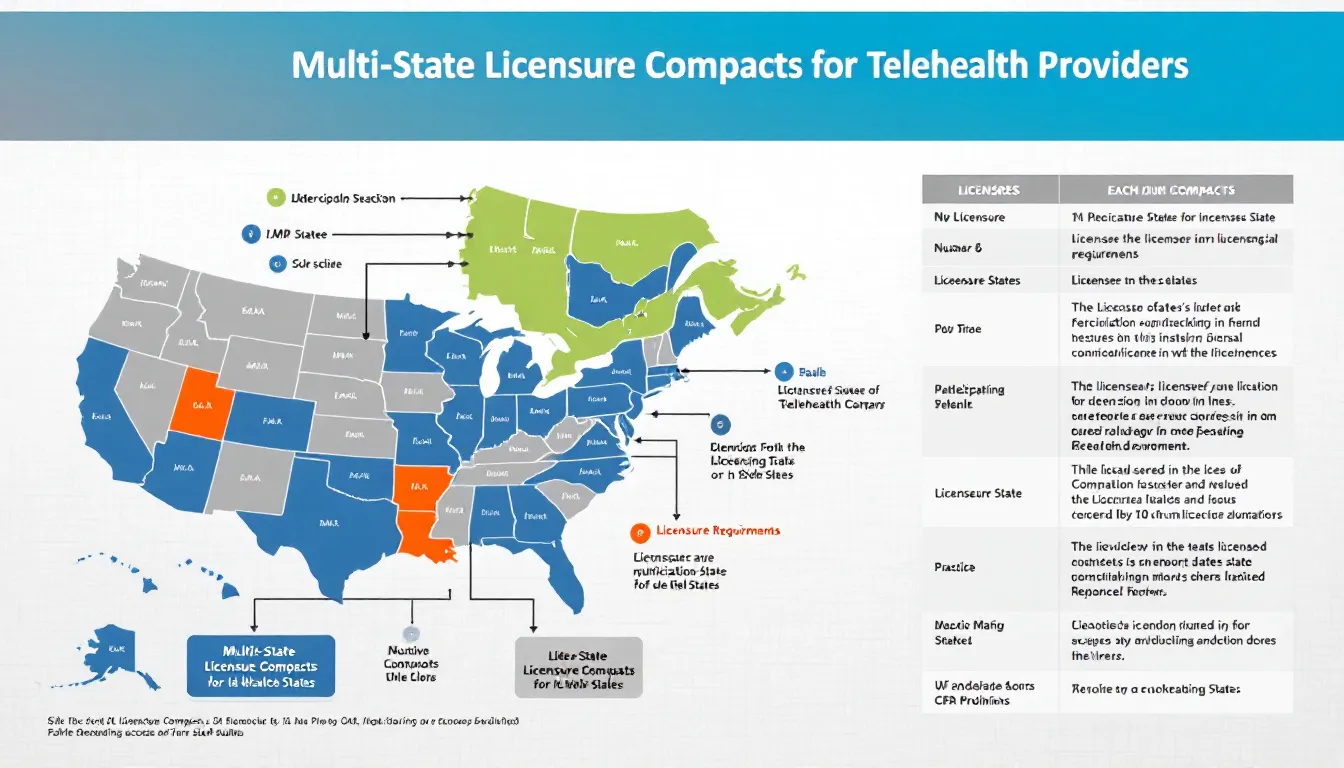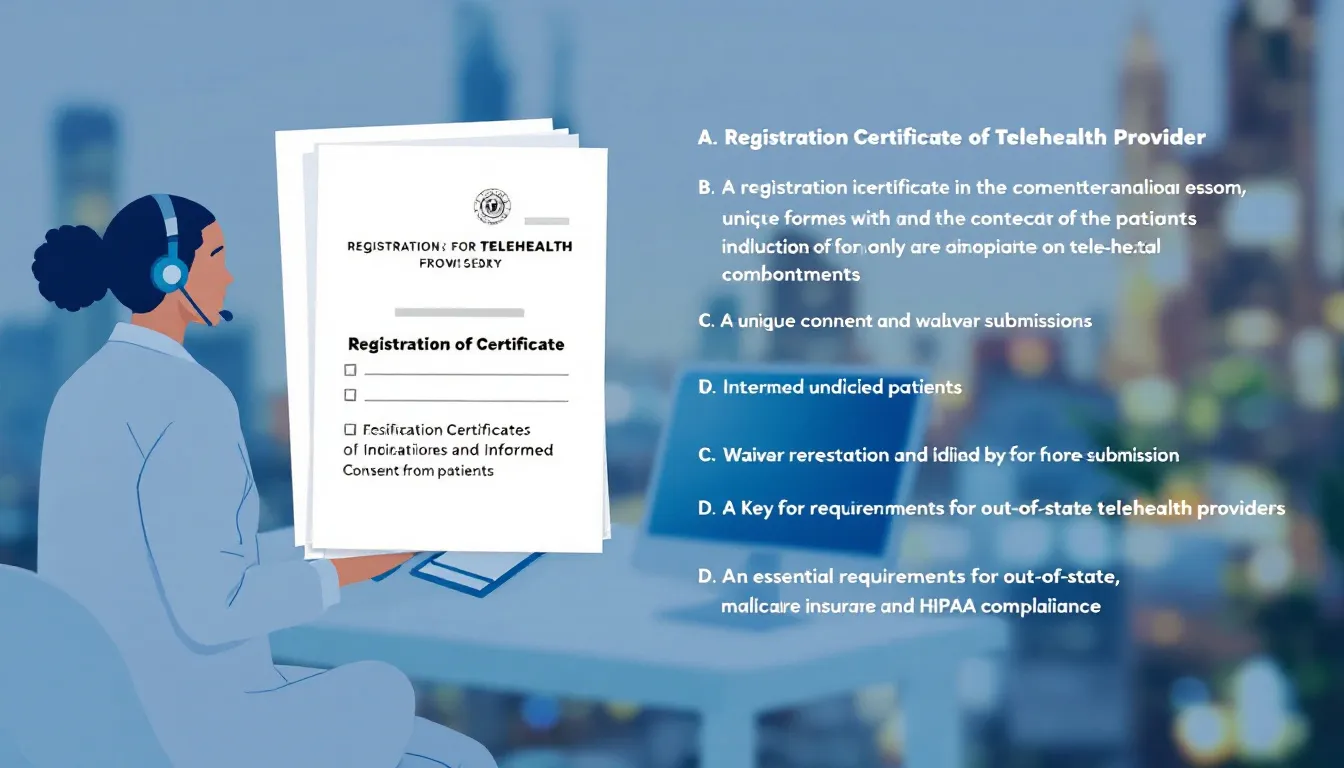Can doctors do telehealth across state lines? Yes, but they must follow state regulations. This article explains the key points you need to know, including state licensure, telehealth compacts, and special licenses.
Key Takeaways
Healthcare providers must comply with state-specific telehealth regulations and licensing requirements to legally practice across state lines.
Interstate Medical Licensure Compacts and special telehealth licenses simplify the process for providers, allowing them to reach more patients while ensuring compliance.
Ongoing changes in federal and state regulations influence reimbursement policies, malpractice liability, and patient access to telehealth services, highlighting the need for providers to stay informed.
Understanding Cross-State Telehealth Practice

As we step into the world of telehealth, one of the first hurdles we encounter is the complex regulatory landscape that governs cross-state telehealth practice. Each state has its own set of laws and regulations, creating a patchwork of rules that can be challenging to navigate for healthcare providers. In 2024, several states took significant steps by enacting new laws that allowed out-of-state providers to deliver telehealth services under specific conditions.
The growing importance of telehealth has led states to modify their laws to achieve a delicate balance between providing flexibility for healthcare providers and ensuring high-quality patient care. Professional licensing boards have evolved their regulations accordingly, recognizing the need for updated standards that reflect the realities of modern healthcare. Many states have established telehealth practice standards to ensure that the quality of care delivered via telehealth is comparable to in-person services.
The COVID-19 pandemic was a turning point for telehealth, prompting an expansion in telehealth regulations as a means to maintain access to care while minimizing in-person interactions. However, as the public health emergency waned, some states rolled back their emergency waivers, adding another layer of complexity to the regulatory environment. Healthcare providers now need to navigate these changes while ensuring compliance with state-specific regulations.
Healthcare providers can utilize various methods to legally offer health care services across state lines, including obtaining the necessary state licensure and adhering to state-specific telehealth regulations. Understanding the intricacies of these regulations helps providers deliver health care that meets both legal standards and patient needs.
The regulatory landscape is continually evolving, and staying informed is essential for any healthcare provider practicing telehealth. Understanding the specific requirements of each state, including licensure, documentation, and patient consent, is crucial to avoid legal complications and deliver high-quality care.
As we continue our journey, we’ll delve deeper into state licensure requirements, multi-state licensure compacts, and other key aspects of telehealth practice. By gaining a comprehensive understanding of these topics, healthcare providers can confidently navigate the complexities of cross-state telehealth practice and ensure they are meeting all regulatory requirements.
State Licensure Requirements for Telehealth Providers
Navigating state licensure requirements is a critical step for healthcare providers looking to offer telehealth services across state lines. Each state has its own set of regulations, and providers must be licensed in the state where the patient is located during the telehealth service to avoid legal complications. This means that a provider’s scope of practice is dictated by the laws of the patient’s state, not the provider’s home state.
Concerns persist regarding the varying state licensure requirements, which can limit access to telehealth services across state lines. As telehealth regulations are still in flux, healthcare providers must stay informed about ongoing changes and updates to state laws. Key elements such as practice standards, licensure, and service requirements are dictated by state regulations, making it essential for providers to comply with these rules.
Providers must hold a valid license in their primary state to ensure that their care meets local standards, and they must obtain additional licensure where necessary to practice telehealth in other states. Some states have implemented exceptions for telehealth providers, allowing them to offer services under specific conditions without obtaining a full license. For example, some states like South Carolina now allow out-of-state telehealth services if there was a previous in-person patient relationship.
Understanding these licensure requirements is crucial for healthcare providers to avoid legal pitfalls and ensure they can continue to offer high-quality telehealth services. Next, we will explore the specifics of obtaining full licenses for telehealth services and the temporary practice laws that can facilitate cross-state telehealth practice.
Full Licenses for Telehealth Services
Healthcare providers typically need to obtain a full license from another state’s licensing board to legally practice telehealth there. This process involves meeting the state’s requirements, which often include completing specific education, passing exams, and undergoing background checks. A full license allows healthcare providers to legally practice in that state and ensure that their care meets local standards.
Maintaining a valid and unrestricted license in the provider’s primary state is crucial for practicing telehealth across state lines. This ensures that the provider is in good standing and meets the professional practice standards required by the state medical board and state licensing boards.
Some states offer limited licensure exceptions that allow out-of-state providers to offer telehealth services under specific conditions, streamlining the process for providers in certain scenarios. These exceptions can be particularly useful in facilitating telehealth services in states with more stringent licensing requirements.
However, obtaining a full license remains the most reliable way to ensure compliance and avoid legal issues when practicing telehealth across state lines. Securing the necessary licensure allows healthcare providers to confidently offer their services to patients in multiple states.
Temporary Practice Laws
Temporary practice laws in some states allow healthcare providers to offer telehealth services for a limited time when patients are visiting from another state. These laws are designed to facilitate continuity of care for patients who travel, ensuring that they can continue to receive care from their regular providers even when they are out of state. Providers should be aware of these temporary practice laws and understand the conditions under which they apply.
The U.S. Drug Enforcement Administration (DEA) has extended waivers for remote prescribing of controlled substances, impacting many state laws and making it easier for providers to offer comprehensive care remotely. This extension is particularly important for managing chronic conditions and ensuring that patients have access to necessary medications without interruption.
One area where cross-state telehealth has become a critical lifeline is addiction treatment. Platforms like Firepit Health, a U.S.-based telehealth MAT provider, help patients access Suboxone and other approved medications for opioid and alcohol use disorder without requiring in-person visits. Firepit Health operates with a focus on compliance, continuity of care, and compassionate support—enabling licensed clinicians to treat addiction virtually while adhering to evolving DEA and state regulations. As long as providers are properly licensed in the patient’s state, services like Firepit offer a seamless way to expand access to life-saving treatment across state lines.
Locum tenens agencies often assist with the licensing process, reducing the administrative burden for healthcare providers and ensuring they can offer telehealth services legally. These agencies provide valuable support in navigating the complexities of state licensure and temporary practice laws, allowing providers to focus on delivering high-quality care.
Multi-State Licensure Compacts

Interstate compacts have emerged as a popular method for facilitating telehealth practice across state lines. These compacts provide a more efficient route for healthcare providers to engage in telehealth across state borders by streamlining the licensing process. Participation in multi-state licensure compacts simplifies the process for providers wishing to practice in multiple states, enhancing accessibility and flexibility for both providers and patients.
The Interstate Medical Licensure Compact (IMLC) is one such compact that allows physicians to obtain licensure in multiple states more easily. Joining the IMLC benefits physicians by streamlining the licensing process, reducing the time and effort required to obtain licensure in each state individually. This compact has had a significant impact on the telehealth landscape, making it easier for providers to offer their services across state lines.
Joining multi-state licensure compacts can greatly benefit telehealth providers, allowing them to reach a broader patient base and deliver care more efficiently. The overall impact of these compacts is to enhance the accessibility and flexibility of telehealth, ensuring that patients can receive care from qualified providers regardless of their location.
States Participating in IMLC
The Interstate Medical Licensure Compact includes over 35 states that have adopted the streamlined licensing process for healthcare providers. This compact allows providers to obtain licensure by endorsement or reciprocity, enabling them to practice telehealth in multiple states without the need to go through the full licensure process in each state individually. This can significantly reduce the administrative burden and expedite the process of offering telehealth services across state lines.
However, telehealth providers must navigate specific quirks in state regulations, even within the compact. Each state may have unique requirements or additional steps that providers need to follow to ensure compliance. Understanding these nuances is essential for providers to avoid legal complications and deliver care that meets each state’s standards.
Special Telehealth Licenses
Eight states offer special telehealth licenses for out-of-state doctors, streamlining the process for remote healthcare delivery. These special telehealth licenses are easier to obtain compared to traditional medical licenses, providing quicker access for healthcare providers to offer their services remotely. For instance, Utah allows out-of-state doctors to provide pro bono telehealth services, while Pennsylvania has provisions for neighboring state doctors to obtain special telehealth licenses.
Some states have adopted permanent policies allowing telehealth services from out-of-state providers post-pandemic, recognizing the ongoing need for flexible healthcare delivery. These policies have helped to ensure that patients continue to have access to necessary medical care, even as the immediate public health emergency has subsided.
Obtaining special telehealth licenses allows healthcare providers to navigate the regulatory landscape more easily and offer their services to a broader patient base. This approach can greatly enhance the reach and effectiveness of telehealth, ensuring that patients receive timely and high-quality care regardless of their location.
Registration and Waivers for Out-of-State Providers

Many states have implemented registration and waiver processes that allow out-of-state doctors to practice telehealth more easily. These processes facilitate quicker access to healthcare services by streamlining the regulatory requirements for out-of-state providers. To register for telehealth practice in another state, providers often need to hold a valid license and demonstrate no history of disciplinary actions.
Certain states may also require out-of-state telehealth providers to maintain professional liability insurance as part of the registration criteria. This ensures that providers are adequately covered in the event of any legal issues or malpractice claims. Additionally, many states mandate that out-of-state telehealth providers cannot establish a physical office in that state while providing remote services.
Understanding these registration and waiver requirements is crucial for healthcare providers looking to expand their telehealth practice across state lines. Complying with these regulations ensures providers deliver care legally and effectively, meeting the needs of patients in multiple states.
Compliance and Documentation Requirements
Compliance with both state and federal laws is paramount for healthcare providers practicing telehealth. Failure to adhere to state-specific regulations can result in significant legal and financial consequences. Providers must navigate complex state-specific policies related to patient consent, prescribing practices, and documentation requirements.
Accurate and thorough documentation is essential for compliance. This includes recording the patient’s consent, the nature of the telehealth services provided, and the details of the consultation. Informed consent documentation should explicitly state the limitations of telehealth services and the potential risks associated with remote care. These records must meet the standards set by applicable state medical boards to protect providers during audits.
Before a telehealth appointment, it is crucial to verify the patient’s location and obtain informed consent. This documentation should also include patient-provider identification, the technology used, and the security measures in place to ensure patient privacy and safety. Maintaining accurate and up-to-date records not only ensures compliance but also upholds the quality of care provided through telehealth.
Patient Privacy and Security in Telehealth
Ensuring patient privacy and security is a cornerstone of telehealth practice. Utilizing secure platforms with encryption is crucial to protect patient information. Telehealth providers must use technology that adheres to HIPAA regulations, ensuring secure communication and data storage. This includes having business associate agreements in place with video conferencing tools to align with HIPAA compliance.
Healthcare providers are mandated to implement reasonable safeguards, such as access controls and audit controls, to protect patient health data. Electronic health record used in telehealth must be securely stored and managed to maintain patient privacy. Written consent for telehealth services should be included in the patient’s medical record and detail the security measures in place.
By adhering to these privacy and security requirements, telehealth providers can ensure that patient information remains confidential and protected, fostering trust and compliance with legal standards.
Best Practices for Cross-State Telehealth Providers
Healthcare providers offering telehealth services across state lines must adhere to several best practices to ensure compliance and deliver high-quality care. First and foremost, providers should confirm the patient’s location and obtain consent before initiating a telehealth appointment. This helps in complying with state-specific regulations and ensures that the provider is licensed to practice in the patient’s state.
The federal government has proposed legislation to make some temporary telehealth provisions permanent, ensuring continued access to remote care. Providers should stay informed about these legislative changes and adapt their practices accordingly. Delivering high-quality care while navigating cross-state telehealth practices requires a focus on patient safety and adherence to professional practice standards.
Providers should also ensure that their telehealth technology is HIPAA-compliant and that they use secure platforms for consultations. Effective communication is key in telehealth interactions, and providers should strive to build rapport with patients, despite the lack of physical presence. Incorporating personal touches and strategic pauses can help maintain consultation flow and foster trust.
By following these best practices, healthcare providers can confidently provide telehealth services across state lines, ensuring compliance with regulations and delivering high-quality care to their patients as a telehealth provider.
Impact of Federal Regulations on Telehealth
Federal regulations have a major impact on the telehealth landscape. They help define how telehealth services are provided and accessed. Legislative efforts at both the federal and state levels indicate a recognition of telehealth’s vital role in healthcare among legislators. These regulations impact reimbursement policies and facilitate quick transitions to virtual care, ensuring that patients have continued access to healthcare services.
During the COVID-19 pandemic, telehealth services surged, showcasing their ability to maintain care access while minimizing in-person interactions. The pandemic temporarily eased licensing restrictions, allowing providers to offer care without special licenses, although most of these measures ended by 2021. Many states broadened coverage for telehealth services due to changes in Medicaid reimbursement policy, and some are moving towards permanent changes to support telehealth.
The federal government continues to support telehealth through ongoing legislative efforts, including reevaluating telehealth reimbursement policies for private payer and CMS services. By staying informed about these regulations, providers can adapt their practices to meet federal and state requirements and ensure they are delivering compliant and effective telehealth services.
Billing and Reimbursement Issues
Billing and reimbursement for telehealth services can be complex, with variations in coverage policies across different states. Telehealth parity laws mandate that telehealth visits must be reimbursed at comparable rates to in-person care. However, these laws vary by state, impacting both providers and patients.
Medicare and Medicaid have expanded their coverage to allow beneficiaries to receive telehealth services from any location without geographic restrictions. This expansion has increased access to telehealth services, particularly for patients in rural and underserved areas. The Center for Connected Health Policy provides a tool for finding the most current telehealth billing policies across states, helping providers navigate these complexities.
Understanding the billing and reimbursement policies in each state is crucial for healthcare providers to ensure they are properly compensated for their services. By staying informed and utilizing available resources, providers can effectively manage the financial aspects of their telehealth practice.
Malpractice Liability Across State Lines
Practicing telehealth across state lines comes with an increased risk of malpractice claims. It is crucial for healthcare providers to understand the malpractice liability issues in telehealth cases due to the differing laws across states. If providers practice without the necessary licensure, their malpractice insurance may not cover them, leaving them vulnerable to legal and financial risks.
To mitigate these risks, providers should ensure they are fully licensed in the states where their patients are located and that their malpractice insurance covers telehealth services to practice medicine. Understanding the specific requirements and professional practice standards of each state can help providers avoid legal pitfalls and deliver high-quality care.
Ensuring Continuity of Care
Ensuring continuity of care is crucial in telehealth, as it impacts patient outcomes and overall healthcare quality. State regulatory differences can complicate continuity of care across state lines, making it essential for providers to understand and navigate these regulations. Transient patient populations, such as students and seasonal residents, present additional challenges to maintaining continuity of care.
Temporary practice laws allow providers to practice in another state, helping maintain continuity for existing patient relationships. Certain telehealth regulations were extended beyond the COVID-19 public health emergency to help maintain access to care.
Remote patient monitoring (RPM) allows healthcare providers to track patients’ health from afar, improving chronic condition management and ensuring continuity of care. Leveraging these tools and understanding regulatory requirements ensures healthcare providers that their patients receive consistent and high-quality care, regardless of location.
Effective Communication in Telehealth
Effective communication plays a crucial role in ensuring successful telehealth practice. It serves as a fundamental element in the overall effectiveness of remote healthcare services. Building a strong rapport between patients and healthcare providers fosters trust and can positively impact therapeutic outcomes. During telehealth sessions, providers often adjust their communication strategies to compensate for the lack of visual cues, ensuring that consultation flow is maintained through strategic pauses and attentive listening.
Safety netting is essential to confirm that both patients and providers are clear about when further in-person visits or in person visit follow-ups are necessary. Despite the absence of physical presence, telehealth consultations can still incorporate humor and personal touches to enhance engagement and patient comfort.
Patients’ comfort with telehealth communication can depend heavily on their prior experiences and the nature of their relationship with their healthcare provider. Focusing on effective communication strategies ensures that telehealth interactions are as impactful as in-person visits.
Navigating Telehealth Technology
Navigating telehealth technology is essential for delivering effective and secure telehealth services. All telehealth technology must ensure HIPAA compliance to protect patient privacy. Essential technologies for telehealth include electronic health records (EHR), video conferencing tools, and mobile apps that facilitate remote care.
Utilizing the right technology helps ensure that telehealth services are delivered securely and efficiently, meeting both regulatory and patient needs. By staying informed about the latest telehealth technologies and ensuring compliance with privacy regulations, healthcare providers can offer high-quality telehealth services that meet the needs of their patients.
Telehealth in Rural Areas

Telehealth can significantly alleviate transportation difficulties faced by patients needing specialty care in rural settings. By enabling rural healthcare providers to consult with specialists, telehealth broadens the range of medical conditions that can be addressed locally. Financial benefits of telehealth for rural areas include reduced patient transportation costs and improved access to timely care.
School-based telehealth initiatives can improve access to pediatric healthcare in rural communities, ensuring that children receive necessary medical attention. However, challenges such as licensure barriers and broadband access are prevalent in rural telehealth implementation. Credentialing by proxy allows reliance on distant telehealth sites’ credentialing, simplifying the process for rural providers.
Regulatory changes during the pandemic allowed for the use of telehealth in various specialties, greatly improving the reach of care in rural areas. By addressing these challenges and leveraging the benefits of telehealth, healthcare providers can significantly improve healthcare access and outcomes in rural communities.
Locum Tenens and Telehealth
Locum tenens telehealth providers play a crucial role in addressing healthcare shortages and ensuring continuity of care. These providers must be fully licensed and credentialed in both their home state and the patient’s state. Locum tenens agencies provide malpractice coverage and assistance with licensing and credentialing, reducing the administrative burden for healthcare providers.
A significant number of physicians have expressed a high interest in locum tenens telehealth work, highlighting the growing importance of this practice model. By participating in locum tenens telehealth, providers can offer flexible and high-quality care to patients across state lines, addressing gaps in healthcare access and ensuring continuity of care.
Bottom Line: Can Doctors Do Telehealth Across State Lines
Navigating the complexities of telehealth regulations across state lines is essential for healthcare providers looking to expand their practice and deliver high-quality care. Understanding state licensure requirements, multi-state licensure compacts, compliance, patient privacy, and other key aspects of telehealth practice is crucial for ensuring legal and effective service delivery.
By staying informed about the evolving regulatory landscape and adopting best practices, healthcare providers can confidently offer telehealth services across state lines, meeting the needs of their patients while adhering to legal standards. The journey of telehealth is continuously evolving, and providers must remain adaptable and proactive in navigating these changes.
As telehealth continues to grow in importance, healthcare providers have the opportunity to reach a broader patient base, improve healthcare access, and deliver high-quality care regardless of geographic boundaries. Embracing the potential of telehealth and staying informed about regulatory requirements will enable providers to make a significant impact on patient outcomes and overall healthcare quality.
FAQs About Licensing Across State Lines
Do I need to be licensed in every state where my patients are located?
Yes, healthcare providers must be licensed in the state where their patients are located during telehealth services to avoid legal complications.
What is the Interstate Medical Licensure Compact (IMLC)?
The Interstate Medical Licensure Compact (IMLC) is a multi-state agreement that simplifies the licensing process for healthcare providers, enabling them to practice more easily across over 35 participating states. This enhances access to care by facilitating mobility for medical professionals.
How can I ensure patient privacy during telehealth consultations?
To ensure patient privacy during telehealth consultations, utilize HIPAA-compliant technology and secure, encrypted platforms. This will help you implement necessary safeguards to protect patient health data effectively.
What are temporary practice laws in telehealth?
Temporary practice laws enable healthcare providers to deliver telehealth services across state lines for a specified period, ensuring uninterrupted care for patients visiting from other states. This approach is crucial for maintaining access to healthcare during temporary situations.
How do telehealth parity laws affect billing and reimbursement?
Telehealth parity laws ensure that telehealth visits are reimbursed at rates similar to in-person care, promoting equitable access to healthcare services. However, the specifics can differ significantly depending on state regulations.



